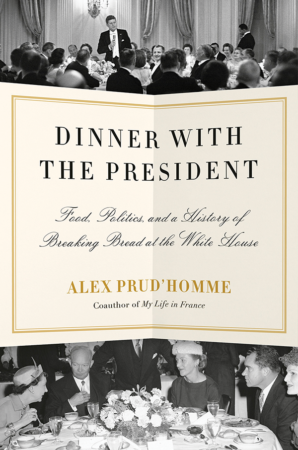The invitation said Black Tie Only and you know what that means.
It means this isn’t some put-on-the-old-feedbag kind of event. You’ll need your best manners, and you should brush up on where the glass goes and what to do with your fork. You don’t want any faux pas attached to your name, no emotionally-charged statements, and let’s hope you’re not self-conscious. As in “Dinner with the President” by Alex Prud’Homme, the world will be watching you eat.
For as long as there’s been a President of the United States, someone’s had to make sure the guy had nourishment because it’s not like he’s got time to run to the kitchen whenever he’s hungry, right? So somebody plans the menu, the First Lady weighs in, the table is set, and in the end, meals with the President have historically been loaded with interesting dishes, culinary quirks, divine desserts, and sour grapes.
To feed the Continental Army, says Prud’Homme, George Washington resorted to theft. Thomas Jefferson knew that great food was a way to put political foes more at ease with one another, while Dolley Madison thought the same with snuff as dessert.
Abraham Lincoln helped cement one of our most beloved national holidays into our lives. Later, Ulysses Grant was known for big dinners of up to thirty-five courses and Theodore Roosevelt held one dinner that caused big controversy. Our heaviest president to date, William Taft, loved a mussel-and-heavy-cream soup called Billy Bi, which probably didn’t help his diet. On the other side was Woodrow Wilson, who was “utterly disinterested in food.”
Herbert Hoover was a speed-eater. FDR loved terrapin soup and considered it a “lucky” dish to serve. Roosevelt’s cook, a Mrs. Nesbitt, was inherited by the Trumans, who intensely disliked her. Mamie Eisenhower called herself a “cooking school dropout.” LBJ used BBQ as a political asset, Bill Clinton’s diet was a closely watched thing, George W. Bush loved his baseball-stadium-themed meals, and Barack Obama ushered in a “foodie” White House that tried to change the way America ate.
So what do you do with the extra spoons, the finger bowl, the sticky butter knife, and do you need four drinking glasses? You won’t need to know any of that to read “Dinner with the President.” You can just sit down and take a bite.
That’s not to say that this book is completely informal: the opulence of a state dinner shines through in the tales author Alex Prud’homme tells, complete with country leaders, ladies in gowns, and tuxes with tails. You can almost see the glitter. On the other hand, the casualness of, for example, an intimate several-hundred-guest barbecue seems charmingly homespun until you remember that, in politics, food isn’t always just food.
There are battles between chefs and chiefs in this book, tasty historical anecdotes, favorite White House dishes that will make you glad you aren’t at that state dinner, and recipes to make you feel positively Presidential. For you, that makes a “Dinner with the President” a book you’ll eat up.
“Dinner with the President: Food, Politics, and a History of Breaking Bread at the White House” by Alex Prud’Homme
c.2023, Alfred A. Knopf
$35.00
480 pages




